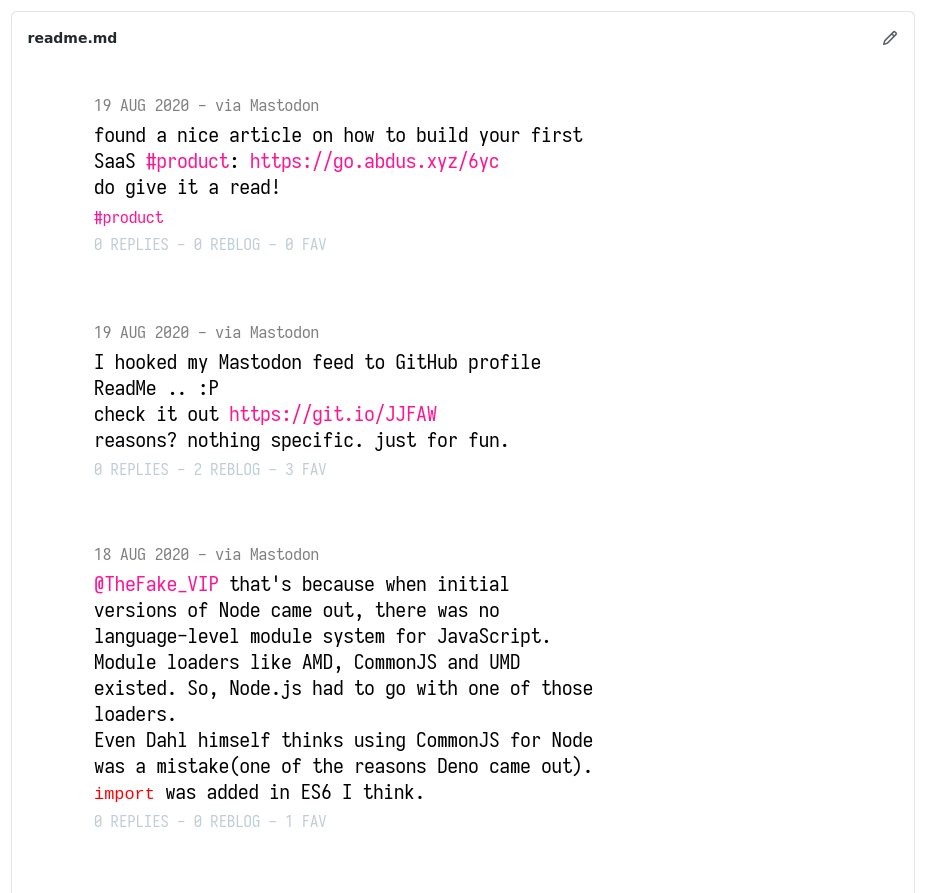Table of Contents

I had this weird idea of using GitHub profile README as Twitter-like(well, Mastodon TBH) feed! There was no specific reason for doing so. I thought it would boost my Mastodon profile(which is quite new at the moment) reach.
Another reason was to see how far I could go with limited tools (as Github ReadMe does not support JavaScript yet).
Generating those Cards
There was only one thing to figure out. How to create beautiful status cards with limited CSS! I knew I could use SVG and make whatever I want. But not all browser supports every feature of SVG yet. So, generating and storing SVG codes as images may not always work.
Since GitHub has introduced workflows(better be late than never), I chose to render SVG on a webpage and convert them to PNG, all in Server-side.
This way, I am assured that SVG would be rendered in the latest browser and converted PNG. But how do I do it?
There is a package called Puppeteer in the NPM registry. This library gives the user a way to control Chromium/Firefox browser programmatically. This, by default, runs browser in headless mode. So, the user would be able to run it without a Desktop Environment.
Getting ‘Toots’ from Mastodon
If you don’t know about Mastodon, you can think of it as Open-Source Twitter! Read more about Mastodon.
Mastodon have an API to fetch public toots of any profile without using an API key. The response is in JSON, so parsing it was quite simple.
Biggest surprise: If I add a Middot (·) somewhere inside SVG, loading image won’t work! It throws an encoding error.
Installing Font
After pushing the initial version to GitHub, I noticed that the font I was
using locally was not available in Github Workflows environment. So, I had to
install them manually. Although I could simply add a font CDN using style
tag within SVG, why not do it the Linux' way? :P
Installing font through command-line as just three simple steps.
- download font as a zip archive
- extract font files to
~/.fontsusingunzip - run
fc-cache -f -vto manually update the font cache
Writing Workflow Steps
I set-up the workflow to run in two events. First is, when I push something to the repository. And second is, on every hour (using a Cronjob). This way, I won’t have to worry about updating ReadMe manually when I post a new toot.
- Setting up Node and NPM was done by an action called
setup-node. - Installing required font was done by a custom bash script I wrote.
- Finally, the image creation script was run using Node, commit the changes, and push them back to GitHub.
And the work is done here!
Conslusion
Sure, this thing was just for fun. But I learnt quite a few new things.
- I can’t use Middot(or similar characters) within an SVG tag. Now I know what to look for when there’s an encoding issue.
- I understand how
action/checkoutworks. This will help me write better workflows in future. - I learnt about some SVG tags. For example,
switchandforeignObject.
If you liked this, I would be happy if you star 🌟 this repository. You can follow me on Mastodon. My handle is @abdus@linuxrocks.online.
Also published in dev.to